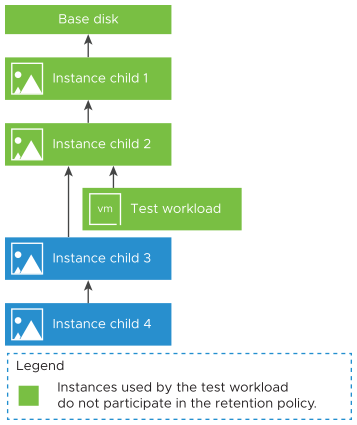To recover a protected workload to a previous state, you can use rotated or stored instances. To avoid the automatic retention of rotated instances, you can store particular rotated instances. The stored instances do not change and you can use them to recover the workload to the stored instance, regardless of the overall retention period of the rotated instances.
VMware Cloud Director Availability supports the following two types of instances to which any protected workload can be recovered.
- Rotated instances:
-
The rotated instances are automatically retained and rotated during the lifespan of the protection.
VMware Cloud Director Availability automatically retains a configurable number of the last rotated instances and allows the workload to be recovered to any one of them.
- Stored instances:
-
The automatic retention does not affect the stored instances.
After manually storing an instance, the stored instance remains unchanged and if the protection is still active, the workload can be recovered to that stored instance.
- Instances cannot interoperate with Changed Block Tracking (CBT) enabled for the source virtual machine. For more information, see Replicating Other Storage.
- Migrations do not use instances.
The automatic retention of a rotated instance can be bypassed by storing it. VMware Cloud Director Availability retains the stored instance until it is no longer marked as stored or until it is manually deleted. Any stored instance, without the latest one allows deleting.

As a result, the read performance of the recovered virtual machine depends on both the hierarchy depth and the instance sizes. The recovered virtual machine achieves better read performance when the instance is closer to the base disk.
- After performing failover or migration, the recovered virtual machine reaches optimal read performance once the instances consolidation completes. The period to consolidate instances depends on the number of parent instances and their size. This consolidation can run for both powered on and powered off virtual machines.
- After performing a test failover, the recovered virtual machine read performance might not be optimal, as instances consolidation does not run. To improve the read performance of the recovered virtual machine when performing a test failover, select an older instance since it is closer to the base disk.
Advanced Retention Rules
VMware Cloud Director Availability 4.3 and later allow configuring multiple retention rules for the rotated instances of the protections.
- In the replication policy assigned to the organization, to allow configuring more than one and up to five retention rules for protections, select Allow advanced retention rules.
When this option is deselected, you can configure only a single retention rule for protections, unless you select an SLA profile assigned to the organization that is configured with multiple retention rules. When using an SLA profile, the maximum number of instances for the replication policy is not taken into account and the instances are restricted according to the SLA profile.
- In the SLA profile assigned to the organization, you can configure up to five retention rules.
When the assigned replication policy does not allow advanced retention rules, in the replication settings of a protection you can select an assigned to the organization SLA profile that is configured with multiple retention rules.
- In the replication settings for a new or an existing protection, you can configure a single retention rule, or if the assigned replication policy allows, you can configure multiple retention rules.
When the assigned replication policy does not allow advanced retention rules, you can select an assigned to the organization SLA profile that is configured with multiple retention rules.
In the SLA profile, or in the replication settings, under Retention policy for point in time instances select Enable retention policy, click Add rule, and create up to five rules, to enable retention rules configuration for the number of rotated instances and their time distance spread apart.
Each retention rule allows selecting the following retention settings.
- Distance
- Select the time distance that the rotated instances spread apart in the current retention rule.
- Unit
-
Select the time unit for spreading the rotated instances in the current retention rule. Select one from:
- Minutes
- Hours
- Days
- Weeks
- Months
- Years
- 10 instances, over distance 10 minutes unit - Retention period: 100 minutes.
- 10 instances, over distance 1 hours unit - Retention period: 10 hours.
- 2 instances, over distance 3 days unit - Retention period: 6 days.
- 2 instances, over distance 2 months unit - Retention period: 4 months.
The total number of instances in this example matches the maximum of 24 rotated instances.
VMware Cloud Director Availability evaluates multiple retention rules from top to bottom and first retains the instances that match the upper-level rules, then proceeds down the chain of retention rules.
- The target recovery point objective (RPO) must always be lower than or equal to the configured retention period distance, or you see a Retention distance should be greater than RPO message.
- Each advanced retention rule can have variable time distance between the rotated instances. From the first to the last rule, the distance for each next rule must increase, or you see a
Retention rules should have increasing distancemessage.
- When reconfiguring a replication from using an SLA profile with multiple retention rules to manually-configured SLA settings with Allow advanced retention rules deselected in the replication policy, shows a
Policy doesn not allow multiple rulesmessage, until you remove the additional rules, leaving only one retention rule.